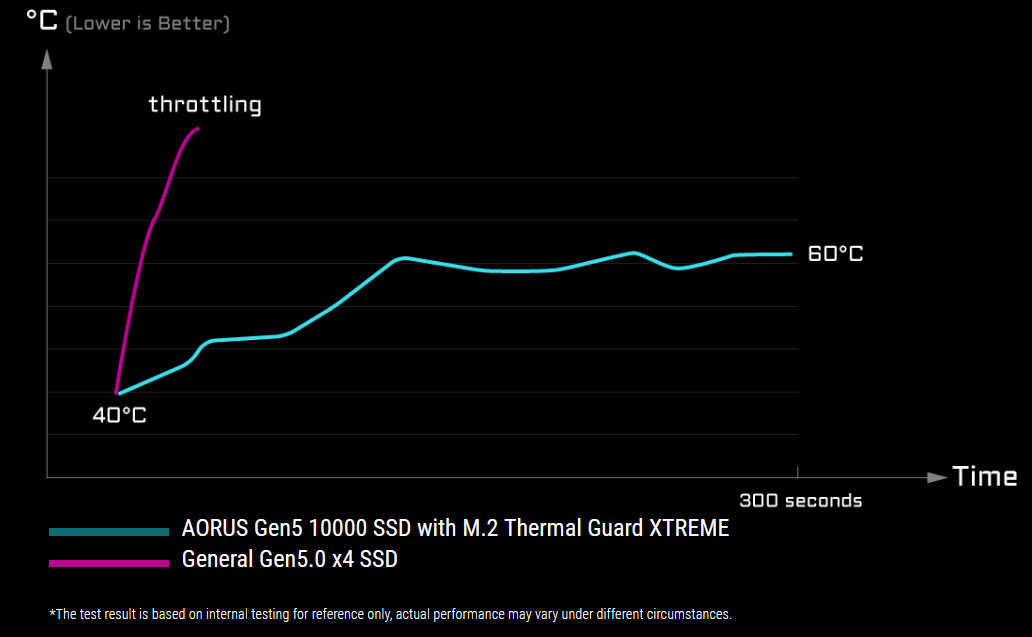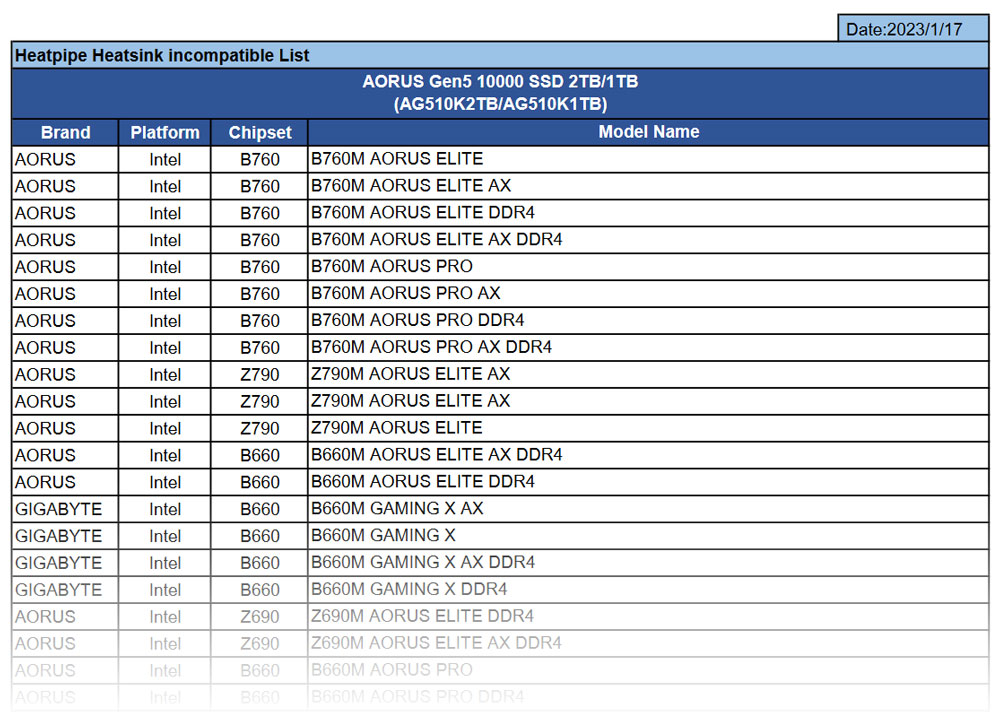Aorus Gen5 10000 1TB and 2TB SSD Full Specs Revealed
But the optional XTREME heatsink isn’t compatible with many motherboards.
Gigabyte shared full product pages detailing the features and specifications for its speedy Aorus Gen5 10000 1TB and 2TB SSDs. The larger capacity M.2 drive is capable of up to 10,000 MB/s reads, and 9,500 MB/s writes. In addition, this SSD comes with Gigabyte’s optional M.2 Thermal Guard XTREME heatsink with two heat pipes and stacked fins with a nanocarbon coating, promising to keep thermal throttling to a minimum. However, as you will read later, there are a lot of systems in which this heatsink won’t fit.
We reported on the Aorus Gen5 10000 when it was announced in August 2022. Our headline reflected this PCIe 5.0 storage Phison E26 platform tested by Gigabyte R&D with next-gen NAND and other components facilitating a 12,450 MB/s read speed. Unfortunately, shipping SSD won't have those stellar read/write speeds. However, the 2TB version of the Aorus Gen5 10000 SSD lives up to its name with up to 10,000 MB/s sequential reads. Read below for additional essential tech specs and a comparison between Gigabyte's 1TB and 2TB models.
|
Aorus Gen5 10000 1TB |
Aorus Gen5 10000 2TB | |
|---|---|---|
|
Interface |
PCI-Express 5.0 x4, NVMe 2.0 |
PCI-Express 5.0 x4, NVMe 2.0 |
|
Controller |
Phison E26 |
Phison E26 |
|
Form factor |
M.2 2280 (80 x 22 x 2.3mm) |
M.2 2280 (80 x 22 x 2.3mm) |
|
Capacity |
1,000GB |
2,000GB |
|
NAND |
232-layer 3D TLC NAND Flash |
232-layer 3D TLC NAND Flash |
|
External DDR Cache |
LPDDR4 2GB |
LPDDR4 4GB |
|
Sequential Read speed |
Up to 9,500 MB/s |
Up to 10,000 MB/s |
|
Sequential Write speed |
Up to 8,500 MB/s |
Up to 9,500 MB/s |
|
Dimensions with heatsink |
92 x 23.5 x 44.7mm |
92 x 23.5 x 44.7mm |
|
MTBF / Warranty |
1.6M hours / 700TBW |
1.6M hours / 1400TBW |
Above, you can see the performance advantages of the larger capacity drive. Unfortunately, Gigabyte has yet to list a 4TB model. Whichever of the two models you may purchase, they consume <11W when active and <85mW when idle.
Extensive compatibility issues with the Heatpipe Heatsink
Now it is time to ponder the specially designed heatsink, or the ‘M.2 Thermal Guard XTREME’, as Gigabyte / Aorus calls it. The M.2 SSD can run bare or with a motherboard-provided heatsink. Still, Gigabyte recommends using the XTREME heatsink, as it is “the best solution in passive airflow conditions when your personal computer adopts a CPU AIO water cooler.”
The chart above shows the benefits of using the M.2 Thermal Guard XTREME heatsink, which stabilizes temperatures under load at approximately 60 degrees Celsius. However, this heatsink could clash with other components in your system, meaning you can’t use it. Probably most surprising is the heatsink’s distinct lack of compatibility (PDF link) with a wide range of modern Gigabyte / Aorus motherboards.
If you own any Gigabyte / Aorus Mini-ITX motherboard, then you can rule out being able to strap on the M.2 Thermal Guard XTREME. The same is true of a vast swathe of motherboards, as shown here. It might have been easier for Gigabyte to list the compatible boards, and it would have been gracious to include other firms’ products. Having said that, the following motherboards are “highly recommended”: the Z790 Aorus Xtreme, Z790 Aorus Master, Z790 Aero G, X670E Aorus Xtreme, and X670E Aorus Master.
It is great to have the product pages and specs to peruse, but at the time of writing, we don’t have the launch pricing or availability for these 1TB or 2TB drives.
Get Tom's Hardware's best news and in-depth reviews, straight to your inbox.

Mark Tyson is a news editor at Tom's Hardware. He enjoys covering the full breadth of PC tech; from business and semiconductor design to products approaching the edge of reason.
-
TechieTwo They are just stating that active cooling is best for the SSD though not a necessity. Obviously with an air-cooled CPU there is enough airflow around the SSD to more than cool the heatsink. If you are using an H2O cooler for the CPU then you have less airflow around the SSD. In most cases the mobo maker supplied low profile heatsink should be sufficient.Reply
You can monitor the SSD temp via S.M.A.R.T if concerned that the SSD might be throttled. -
Friesiansam I strongly suspect the "incompatible list" is a long way from being comprehensive.Reply -
simfreak101 If this is the answer by manufactures, then i predict this will be the death of the M.2 slot;Reply
Time to move u.2 or u.3 to the consumer market like they did for SATA (from SAS). -
Amdlova Just buy a highpoint 650us spend more 600 in ssd put in raid 0 mode call the cops and show your 28.000 mb/sReply -
Geef It should come with a PCI-E expansion card for M.2 drives that rotates the M.2 sideways so the heatsink points away from motherboard.Reply
Issue resolved. -
bill001g Reply
Except many motherboard do not have pcie5 lanes to all the slots. Many only provide pcie5 lanes to the slot for the GPU.Geef said:It should come with a PCI-E expansion card for M.2 drives that rotates the M.2 sideways so the heatsink points away from motherboard.
Issue resolved.
I did not read it closely but there is a lot of discussion why they all put the m.2 slot that supports pcie5 so close to the video card. This would not be a problem if they just put the m.2 slot that supported pcie 5x4 farther away from the video card.
Seems there is some issue running these faster lanes more distance from the cpu chips. -
Math Geek as far as i know, it is a latency issue. the further away from the cpu, the higher the latency for data transfer. sure it is very minimal difference, but at those speeds a couple micro seconds changes the game a lot.Reply
there is no other place to put the slot close to the cpu since the other sides are the vrm's, ram slots, power connections and so on.
i'd personally like to see them leave a mobo with 2 ram slots (instead of 4 most people don't even populate fully) and then add some type of vertical m.2 slot after the 2 ram slots. could be interesting and allow a lot more room to actively cool it if needed. -
bit_user I hope we start seeing more U.2 drives in the consumer space. Those are definitely easier to cool, swap out, and won't interfere with GPUs, etc.Reply -
bit_user Reply
You know the speed of light is about 300 mm per ns, right? And I've read a conservative estimate of the propagation speed of electric signals in copper is about half that. So, each ~150 mm of copper adds only 1 ns. Minimum NVMe read latency figures are well into the range of microseconds. In other words, it's not about latency.Math Geek said:as far as i know, it is a latency issue. the further away from the cpu, the higher the latency for data transfer. sure it is very minimal difference, but at those speeds a couple micro seconds changes the game a lot.
Now, it could relate to cost, although I've read that even PCIe 4.0 boards had to use PCIe retimers. So, if we assume they're using retimers either way, then perhaps they could get a little more distance? I dunno.
Yeah, M.2 slots would seem to complicate board layout, a lot. Yet another reason I don't like 'em.Math Geek said:there is no other place to put the slot close to the cpu since the other sides are the vrm's, ram slots, power connections and so on.
I know, right? Especially when Alder Lake had that horrible penalty (reducing from 4800 to 4400) for having a 4-slot board, even when only 2 slots were populated!Math Geek said:i'd personally like to see them leave a mobo with 2 ram slots (instead of 4 most people don't even populate fully)
Luckily, I think that issue was resolved in Raptor Lake?
Some server boards even have PCIe slots practically in the middle of the board, well away from the backplane. I'm not sure quite what that's all about.Math Geek said:and then add some type of vertical m.2 slot



